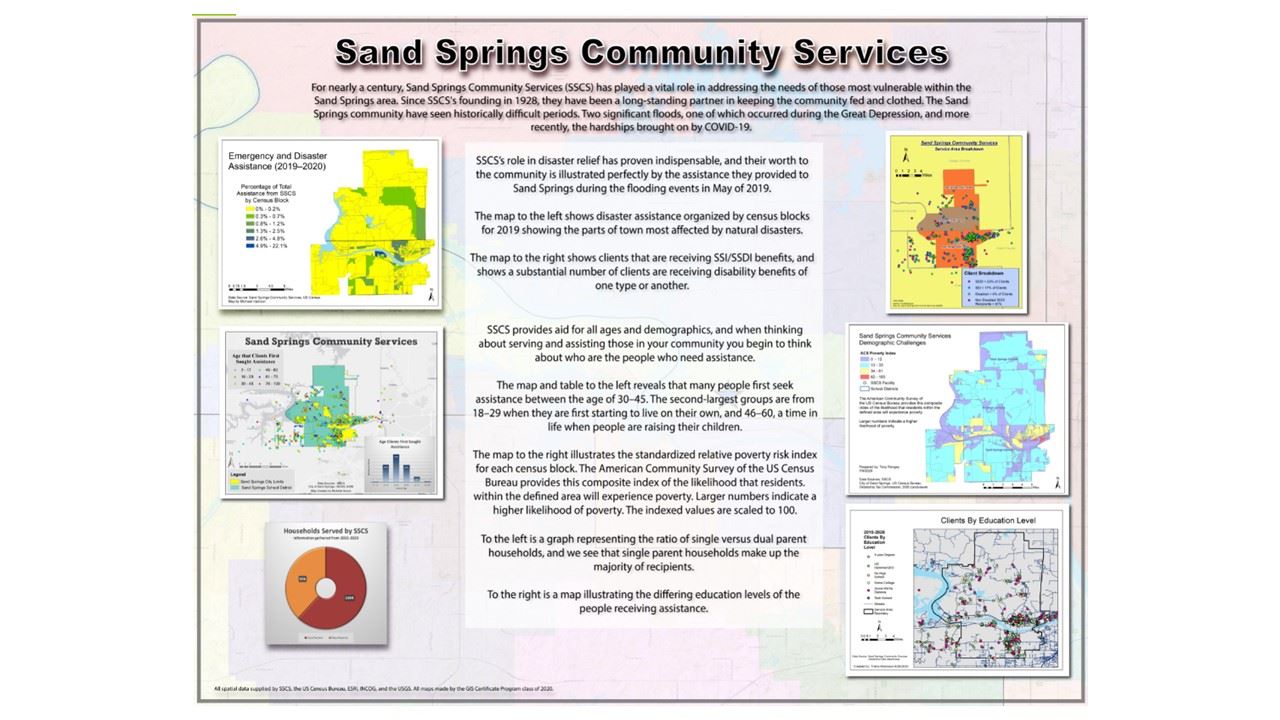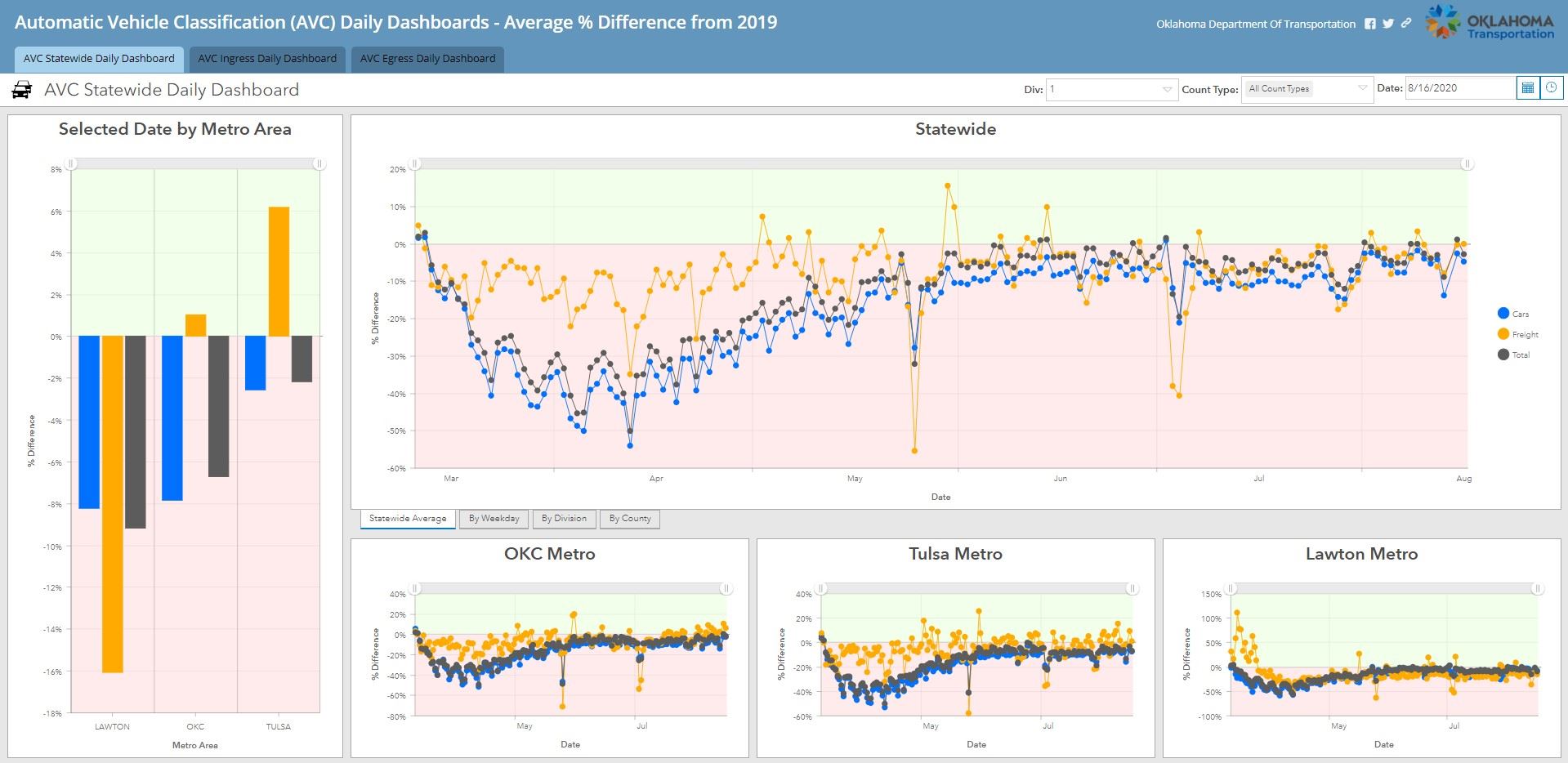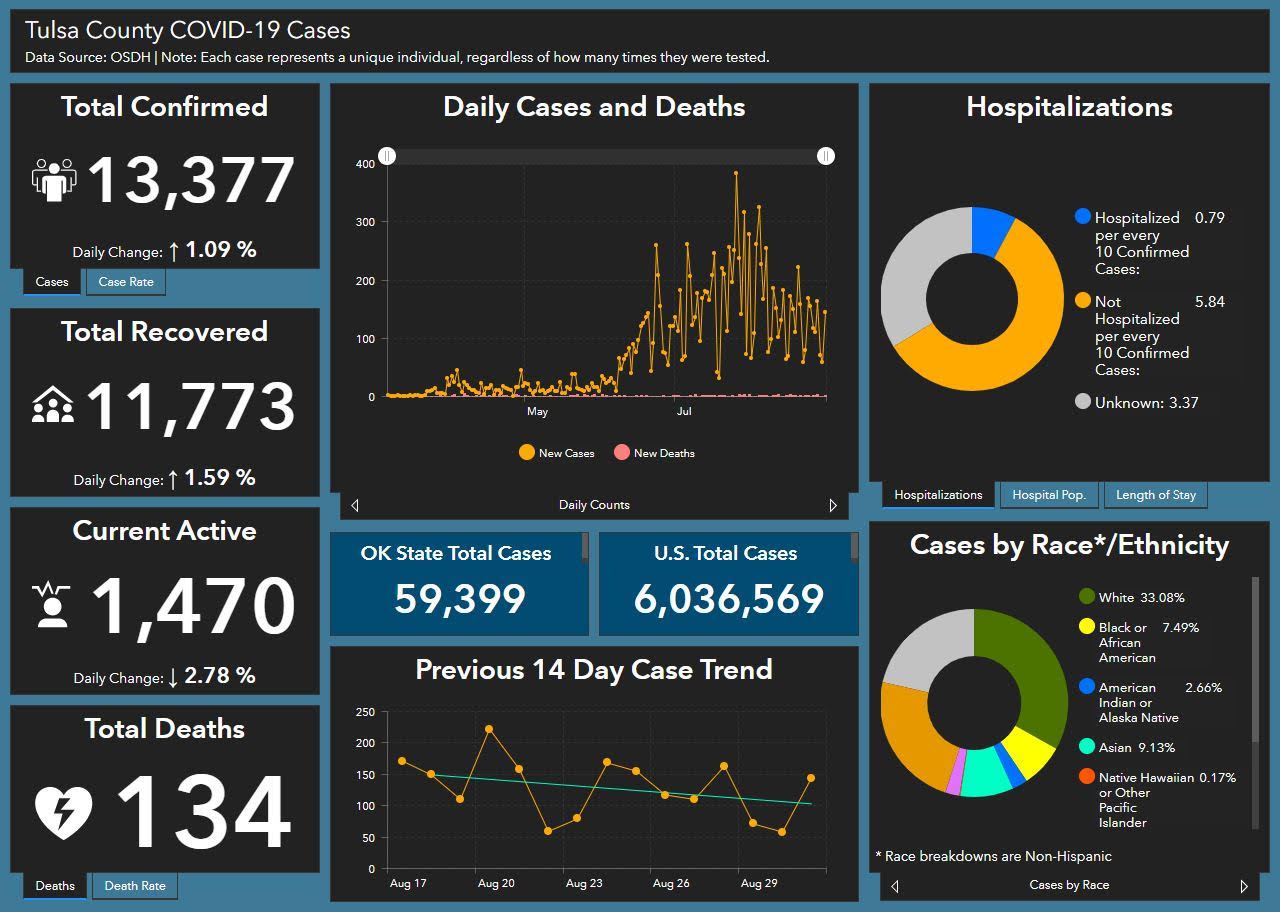


Note: There is no limit to the number of any type of poster entries we can take!
Must register for the OKSCAUG Conference to submit a poster entry.

Sand Springs Community Services Michelle Mount, Michael Harrison, Tony Rongey, Trisha Robinson, Doug Wehmeyer City of Owasso, OK As part of our final research project to complete our GIS Practicum at Tulsa Community College, the authors worked with Sand Springs Community Services to analyze the data collected as they served their clients. The team looked at financial assistance and its distribution across the service area. Our second area of focus was in looking at client demographics and the in area and out of area assistance they provided. The poster give a small snapshot of the analysis and maps we produced. | Determining Fire Severity of the Santa Rosa, CA 2017 Fire John W. Cortenbach - Humboldt State University Department of Environmental Science and Management Richard J. Williams - Humboldt State University Environmental Resources Engineering Buddhika D. Madurapperuma - Humboldt State University Department of Forestry and Wildland Resources This study examines the 2017 Santa Rosa wildfire using remote sensing techniques to estimate the acreage of burned areas. Landsat 8 imagery of the pre- and post-fire areas was used to extrapolate the burn severity using two methods: (i) difference Normalized Burn Ratio (dNBR) and (ii) change detection analysis. We compared our analyses with data provided by the California Department of Forestry and Fire Protection (Cal Fire). The results of burn severity using both methods were on average 24% under-approximated in comparison to Cal Fire values. When comparing our acreage burn analysis to Cal Fire data, our results were on average 76 ± 8% accurate in identifying burn severity. Of the two methods, the change detection using an iso-clustered unsupervised classification scheme was more accurate. Landsat-based burn severity mapping provides cost–effective tools for forest managers to identify fire risk areas for wildfire planning and ecosystem management. | Air Pollution in Texas: Locked down by COVID-19 Abhishek K. Kala*, Samuel F. Atkinson, Chetan Tiwari University of North Texas, Advanced Environmental Research Institute, University of North Texas, Denton, TX Air is one of the critical natural resources that is vital for human health. In the U.S., poor air quality is the cause of around 60,000 premature deaths annually and over $150 billion in costs related to air pollution-driven illnesses. The outbreak of pandemic COVID‐19 has caused tremendous impacts on public health and economy across the world leading to strict lock down measures to reduce its spread. The silver lining of this tragic outbreak is the improvement in air quality in many areas as a result of an unprecedented reduction in global economic and transportation activities. In this study we examined the changes in the concentration of nitrogen dioxide (a useful proxy for human activities) for the state of Texas. We utilized freely available datasets and ran our analysis using the open source Google Earth Engine platform. It is evident that the counties in Texas experienced improvement in air quality during the lock down period. |
Uncovering the hidden patterns in complex epidemiological datasets Abhishek K. Kala*, Samuel F. Atkinson, Chetan Tiwari Tessellations Inc. This study postulates that underlying environmental conditions and a susceptible population’s socio-economic status should be explored simultaneously to adequately understand a vector borne disease infection risk. Here we focus on West Nile Virus, a mosquito borne pathogen, as a case study for spatial data visualization of environmental characteristics of a vector’s habitat alongside human demographic composition for understanding potential public health risks. We propose that the use of geovisualization tools may provide a glimpse into the large number of potential variables influencing the disease and help distill them into a smaller number that might reveal hidden patterns. This geovisual look at the data might then guide development of analytical models that can combine environmental and socio-economic data. Our results suggest that simultaneously visualizing these datasets supports a fuller understanding of the underlying spatial processes for risks to vector-borne disease. | The Hospitality District of Midwest City Marianna Sikkar City of Midwest City, OK A poster-sized (2'x3') map developed for the Convention/Tourism Manager to emphasize the lodging, convention and entertainment venues, and restaurants in the Hospitality District of the City of Midwest City. It was created using ArcGIS Pro. | Oklahoma City Metropolitan Area Tree Canopy Assessment Hannah Nolen Association of Central Oklahoma Governments (ACOG) The Oklahoma City Metropolitan Area Tree Canopy Assessment was the first of its kind conducted within a 536 square mile study area in the central part of the state of Oklahoma. The comprehensive assessment identified and quantified the area's land cover, structure, and numerous environmental benefits. Trees contribute to energy savings, air and water quality improvements, stormwater interception, quality of living, and other socioeconomic enhancements. Trees also provide aesthetics and beautification back to neighborhoods and the community at large. |
Stefan Stamenov, Vanya Stamenova Space Research and Technology Institute - Bulgarian Academy of Sciences (SRTI-BAS) The medieval town of Pliska existed from the end of 7th century till the mid of 11th century. From the beginning of its existence until the end of 9th century it was the first capital of Bulgaria. The archaeological exploration of Pliska started in 1899 and with some interruptions it continues today. The medieval town was divided into two parts. The Outer Town is a region of approximately 23 sq. km surrounded by an Earthen rampart and a ditch and the Inner Town is a stone fortress occupying an area of 48 hectares. Because of its smaller size and the importance of its structures, the Inner Town tends to be much better explored as a result of which we know its history in more detail. The Outer Town which is spread on a vast territory and comprises many sites and structures has been relatively less excavated and studied. | Map of Sofia City territorial expansion: 140 years of human impact Stefan Stamenov, Vanya Stamenova Space Research and Technology Institute - Bulgarian Academy of Sciences (SRTI-BAS) This map shows the expansion of the territory of the city of Sofia from the end of the 19th century to the present, showing the boundaries of the city in different years. It represents the increasing of the anthropogenic impact on the territory of Sofia Valley over the last 140 years, after its selection as a capital of Bulgaria in 1879. The region of Sofia City is a good example of the growing human impact over nature for the last century. In the end of XIX century Sofia is a tiny town with 12 000 citizens only and the area of Sofia Valley is almost untouched by the industrialization and the modern infrastructure. Today it is a city with 1.2 million citizens. This is the most urbanized area of Bulgaria. |


Average Percent AADT Difference from 2019 Gwendolyn Johnson - Oklahoma Department of Transportation Due to COVID-19 and the subsequent Stay-At-Home orders the Oklahoma Department of Transportation (ODOT) knew the state Average Annual Daily Traffic (AADT) counts would be affected this year. This web app shows the collection of Dashboards created by ODOT's GIS branch to show how the traffic counts compared to the average counts from 2019. This analysis will help ODOT's senior staff and the Governor's office see the how traffic counts are affected by the pandemic, as well as determine how this will affect the state's reporting to the Federal Highway Administration in 2020. | Tulsa County COVID-19 Data Dashboard Kiran Duggirala - Tulsa Health Department This dashboard was developed in ArcGIS Online to share Tulsa County COVID19 data to the public. This dashboard hosts total of 26 data panels at this point of time and may grow based on future data needs. | Marcus Arreguin - City of Longview, TX The Longview Transit App has been featured in the Esri UC Plenary Session for the last two years. To give some background on the project, Longview Transit serves the city of Longview with bus and paratransit services. Longview Transit operates six routes that cover most of the city of Longview and run six days a week. In 2017, I began updating our data on the bus routes and stops, utilizing information from Longview Transit, remote sensing, and field verification. I used this data to create a web app in 2018 that shows bus users the routes, stops, and pop-ups related to the stops and gives directions to or from bus stops. The app also helps Longview Transit with planning route and stop modifications. Recently, Longview Transit has made extensive changes to its routes, and I have implemented updates to the data and web app, at the same time enhancing the app. Users of the app can now see published bus arrival times labeled on the stops to better help them plan their commutes. |
The Oklahoma Historical Aerial Photo Inventory Web App Madeline Dillner Oklahoma Corporation Commission Brownfield Program The OCC has georeferenced thousands of historical aerial photographs for the state of Oklahoma. We use these photos in-house for Phase I Environemental Site Assessments and environmental case research. We have also given our georeferenced photos to OKMaps to host of their FTP site, and built this web app that has the footprints of georeferenced photos and links to the files on the FTP site. This web app is accessible to the public and has been accessed 3,266 times in the past year alone. Note: Madeline is an OKSCAUG Steering Committee member and is not eligible to win, but she loves her job and is proud of the products her program has created! | Chaya Balsiger City of Tulsa GIS Services This is an application created for the public to view the specials offered by businesses for 918 day in Tulsa. A survey using Survey123 was created for the businesses to submit their information, including business name, description of the special, a photo to show what the special was and location of the business. An internal editor application was created for quality control over the submitted surveys before it was shown on the public web application. | Colin Brooks Oklahoma Corporation Commission Induced Seismicity Department This Operations Dashboard shows various statistics relating to seismicity in Oklahoma since 2015. |






